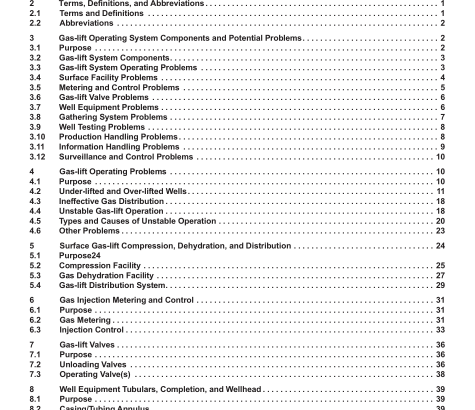API RP 19G5:2019 pdf free download.Operation, Maintenance, Surveillance, and Troubleshooting of Gas-lift Installations
4.2 Under-lifted and Over-lifted Wells
4.2.1 General A gas-lift well is under-lifted when the depth of gas injection is shallower than necessary for optimum lift or the rate of gas injection is too low, or both. Both of these conditions can lead to ineffective lift gas utilization and lower than desired production. A gas-lift well is over-lifted when the rate of gas injection is too high or the gas injection pressure is too high, or both. These conditions can lead to ineffective lift gas utilization. Less than optimum gas-lift exists when a large increase in injection gas rate results in a small gain or even a loss in production.
The objective is to use the total available injection gas in an optimum way to maximize the total oil production rate. Over-lifting can also cause high casing pressures and reopening of upper unloading valves resulting in much less efficient use of lift gas and wear on unloading valves. When the compressor capacity exceeds optimum injection gas required for the group of wells, the criteria of flow stability can be applied. Stability requires a velocity of about 6 ft/sec (1.83 m/sec) in the gas-lifted mixture in the tubing string above the injection point.
4.2.2 Practices for Under-lifted and Over-lifted wells The following practices are recommended and should be followed for under-lifted and over-lifted wells.
— Monitor the performance of each gas-lift well using flowing pressure and temperature surveys, and static pressure surveys, in conjunction with accurate well test and injection information, to determine (or estimate) the current producing gradients, depth(s) of gas-lift injection, FBHP(s), and inflow performance. Use this data to create a calibrated computer model for use in surveillance and troubleshooting. Apply the same procedures to natural flow wells that will eventually be artificially lifted.
— As an alternative to a flowing pressure and temperature surveys, a CO 2 tracer survey method may be used to determine the depth(s) of gas-lift injection. Here, a small amount of CO 2 is injected along with the injected gas-lift gas. The return production is monitored and the time for the return of the CO 2 is determined. The time of the CO 2 return is correlated to the depth(s) of injection from the casing annulus into the tubing. This method can be used on both single and dual string gas-lift wells.
— Use a calibrated computer model, with current operating conditions, to detect a well that is being under-lifted, and to predict the optimum gas-lift injection rate, pressure, depth, and expected increase in production from solving the problem.
— Maintain the desired gas-lift injection control with
a gas measurement system and an automated control valve to maintain the desired injection rate and pressure. — Find over-lifted and under-lifted wells using flowing and temperature gradient surveys, or the CO 2 method described above, and production tests that include injection gas measurement. Gas saved in one group of wells may be used to advantage in other wells.
— Increase the injection rates to non-optimal rates in some wells (if necessary, on a temporarily basis) to obtain stability by achieving a mixture velocity of approximately 6 ft/sec (1.83 m/sec) above the point of injection. If this condition persists, however, the well should be redesigned to overcome the instability problem by increasing the injection rate. Most gas-lift computer models can calculate the mixture velocity.
— Evaluate the effects on surface facilities caused by temporary over-injection in wells, if this practice is used to maintain stability.
— Verify that the gas-lift valves are properly constructed, assembled, and set before they are installed. Use gas-lift valves manufactured to API 19G2 specifications. See API 19G2 for repair and reassembly.
— Check and probe test individual valves to verify conformance with design specifications for critical applications, or where there are ongoing problems. See API 19G2 for gas-lift valve testing and modeling procedures.
— Identify wells that are being under-lifted and check for an inadequate supply of gas due to pipeline restrictions or limited compressor capacity. Evaluate the wells and establish a production priority or optimum gas-lift allocation, or both (see API 11V8). API RP 19G5 pdf download.API RP 19G5:2019 pdf free download
